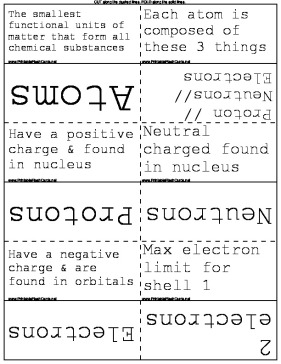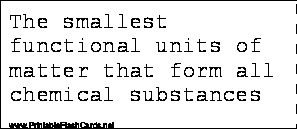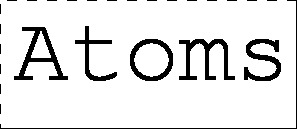

Great for chemists and physicists, these flash cards focus on atoms and their structure
There are 30 flash cards in this set (5 pages to print.)
To use:
1. Print out the cards.
2. Cut along the dashed lines.
3. Fold along the solid lines.
Sample flash cards in this set:




| Questions | Answers |
|---|---|
| The smallest functional units of matter that form all chemical substances | Atoms |
| Each atom is composed of these 3 things | Proton // Neutrons// Electrons |
| Have a positive charge & found in nucleus | Protons |
| Neutral charged found in nucleus | Neutrons |
| Have a negative charge & are found in orbitals | Electrons |
| Max electron limit for shell 1 | 2 electrons |
| Max electron limit for shell 2,3,4,etc | 8 electrons |
| Electrons in outer shell available to combine with other atoms: | Valence Electrons |
| Atomic# equals number of: | Protons and eletrons |
| Has same number as protons if net charge is 0 | Electrons |
| Atomic mass is the SUM of: | Protons and neutrons |
| Can be determined by subtracting atomic# from atomic mass | Neutrons |
| Multiple forms of an element that differ in the number of neutrons | Isotopes |
| All living organisms are made up of these 4 elements: | Hydrogen // Oxygen // Nitrogen // Carbon (CHON) |
| Occur primarily in water | Hydrogen // Oxygen (h20) |
| Found in proteins | Nitrogen |
| Building block of all living matter | Carbon |
| Atoms join together by these 3 bonds | Covalent // Hydrogen // Ionic |
| Bonds having atoms sharing a pair of electrons | Covalent Bonds |
| This is an atom or molecule that has gained or lost 1 or more electrons | Ion |
| Forms between atoms of DIFFERENT electronegativity | Polar Covalent Bond |
| Forms between atoms with SIMILAR electronegativity | Nonpolar Covalent Bond |
| The _____ from one polar molecule is attracted to an electronegative atom of another atom | Hydrogen Atom |
| Ionic bond with a net + charge | Cations |
| Ionic bond with a net - charge | Anions |
| Occurs when a cation binds to an anion by electrostatic attraction | Ionic Bonds |
| An atom with a single, unpaired electron is known as: | Free Radical |
| Can be inactivated when molecules donate electrons to them | Free Radicals |
| The arrangement of atoms will determine the: | Shape of resulting molecule |
| _____ will determine its physical properties | Shape of moelcule |